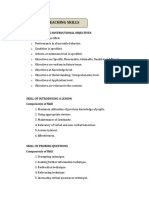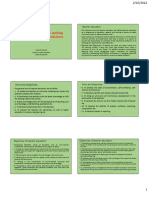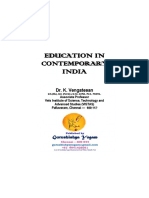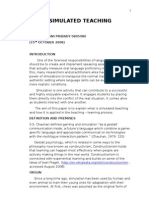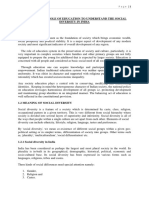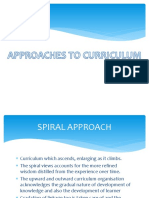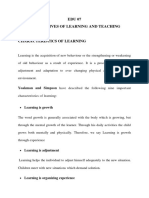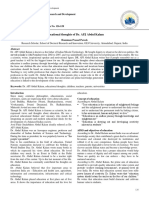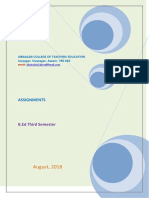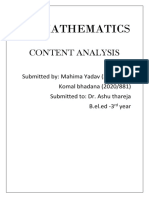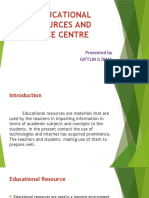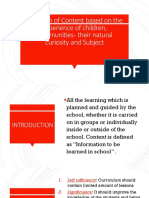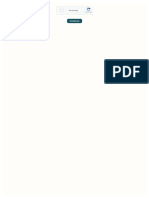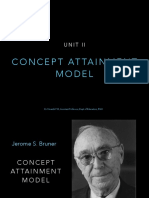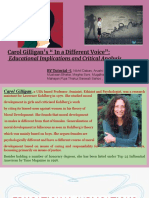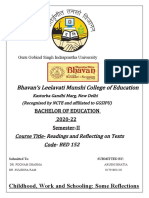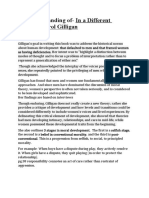0 ratings0% found this document useful (0 votes)
978 views110 pagesLearning and Teaching
Uploaded by
Arushi BhatiaCopyright
© © All Rights Reserved
We take content rights seriously. If you suspect this is your content, claim it here.
Available Formats
Download as PDF or read online on Scribd
0 ratings0% found this document useful (0 votes)
978 views110 pagesLearning and Teaching
Uploaded by
Arushi BhatiaCopyright
© © All Rights Reserved
We take content rights seriously. If you suspect this is your content, claim it here.
Available Formats
Download as PDF or read online on Scribd
You are on page 1/ 110
x
ae.
‘
eeds, Drives end Incentives
. — Trait cum Type Approach -
- Psycho-znz!ytic Approach
umanisid Approach
ee of Cloth?
ce Quotient : 285
rning and Teaching
267
rosessing Theory of Intelligence 268
ory ef Multiple Intelligence 270
277
278
279
280
281
282
284
285
286
287
290
290
292
293
¢ Learners and Teachers 294
294
es for Motivating the Students 299
.g. Strengthening and Sustaining Motivation 302
304
304
308
309
311
315:
316°
320
323
18. Adjustment — Meaning, Nature and Methods 324
and Definittons of Adjustment
Adjustment as Achiewement or Process
Areas of Spheres of Adjustment
- Personal Adjustment
= Sociel Adjustment
- Occupational Adjustment
Chsracteristics of a Well Adjusted Person
Methods of Adjustment
- Direct Methods —
— Indirect Methods
Referencts and Suggested Readings
Study Questions
> 324
of Adjustment—In the Context of Teaching and Learning 325
326
327
327
329
2
333
334
337
343
Scanned with CamScanner
oe
BELL LLL LE EOL Lee CL eC CLE Le Pe Ce eee eee Lee eer ere
See eee eee eee ee ee ee eee
oer
1
Learning and Teaching —
Nature and Relationship
CONCEPT OF TEACHING
The general notion, popular opinion and the image which we form about an
object, people or idea is termed as our concept about them. It is the result of
our experiences direct and indirect which we: happen to gain about objects,
people or ideas. The same is true also for the concept of teaching. By the
term concept of teaching we mean all that which we know or ought to know
about teaching in terms of its meaning, nature, and characteristics and all
that which can distinguish it from the othersimilar concepts and activities,
Looking in this way, if we intend to know thoroughly about the concept of
teaching we have to look it from the various angles like below:
© Understanding its meaning and defining it.
Knowing about the nature and characteristics of teaching.
Comparing teaching with other similar cencepts. i
Knowing about the relationship of teaching and learning.
Discussing about the analytical concept of teaching.
Understanding teaching in term of its variables.
eoeee
Meaning and Definitions of the Term Teaching
Teaching in its simple meaning is referred to either as occupation or
profession of a community known.as teacher or an activity or activities of a
group undertaken to help an individual to lea or acquire some knowledge,
skills, attitudes or interests, etc.
However, the meaning and concept of teaching is not.so simple as
interpreted above. It is a quite complex-social, cultural and ethical process
designed in a social or cultural context.
By all means and in any shape, it is always designed in.a social context
and therefore related with the,social structures, cultural environment, values
and ideals of the people, society and -the government. All these factors
always stand for dynamicity and therefore, the meaning and definitions of
teaching have always been in a state of change depending upon the need of
lace and society. It has resulted into various definitions of the term
! , teaching. Some of such definitions are reproduced below.
Cod
Scanned with CamScanner
Learning and Teaching — Nature and Relationship 3
learn something. Teaching may be carried out in the absence of a teacher A
book, nature, teaching machine, tape recorder, etc. may play a role of
teacher, The important thing is the role of a system of actions or activities.
If it results in some or other types of learning then this system may be
termed as teaching. The weakest point of the above definition lies in the fact
that it does not mention all the elements of the teaching process, namely, the
teacher, taught and the subject matter.
To do away with the above weakness. Smith tried to elaborate his earlier
definition, in 1963, by considering teaching as a tripolar process involving:
(i an agent (the source, human or material that tries to produce
Jearning),
(ii) a goal or target that is to be achieved through the process of
teaching, and
+ (iii) the intervening variable consisting of learning or teaching
situation or environment. It may involve physical or human
material, conditions and instructional methods.
|
|
!
The definition given by Gage (1962) takes teaching as ‘a process
establishing interpersonal relationship between the teacher and the taught as
a result of which the behaviour of the latter is modified. Here the
relationship plays the key role. In this age of sophistication this typ: of
approach is unable to explain the role of hardwares, programmed
instructions and teaching machines where the bond of interpersonal
relationship is somewhat missing.
The next definition given by Amidon (1967) considers teaching as a
Process of interaction between the teacher and the taught. It considers
teaching as a co-operative enterprise, a two way traffic and a commonly
shared phenomenon. It results in the improvement and development of both
the participants i.e., teacher and the taught. It considers teaching as a set of
Properly planned and clearly defined activities that are undertaken for the
achievement of certain objectives. This definition too is limited in the sense
that it confines teaching within the interaction of the teacher and taught and
that too primarily in the form of class-room talk or a few special activities.
Clarke (1970) in his definition has tried to broaden the base/scope of
teaching by taking it as a set of all those organised activities that may result
in bringing some change in the behaviour of the pupil or leaner.
A year later Green (1971) in his definition tried to delimit the boundary
and scope of teaching task. He has defined teaching as a profession or
occupation by stating that teaching’ is what a teacher does for the
development of a child.
Actually this is a very narrower and misnomer concept of the term
teaching. Neither teaching can be, restricted to a profession or occupation of
a people or community like teacher nor it can be always relied for bringing
desirable improvément or development in the behaviour or functions of the
Scanned with CamScanner
1 os
Fs Learning and Teaching
ing is an intimate contact between a more
Morrison (1934). "
ae Pp in mature one which is designed to further
SOR andal
hing is an arrangement and manipulation
ips and obstructions which an
and from which he will learn’in the
Teaching is a system of actions ii
fended to produce
s is a form of inter-personal influence aimed
Potential of another pérson.”"
28 iS @ system of actions involving an agent,
situation including two sets of factors — thove
agent has no control (class size, size of classroom
I ck: istics of pupils, etc.) and those that he can modify
of asking questions about instruction and ways Of structurin,
: formation or ideas gleaned)” c
i _ Edmund Amidon (1967). “Teaching is defined as an interactive process,
involving classroom talk which takes place between teaches
'P ? and occurs during certain definable actWities.”
Clarke (1970). “Teaching: refers to activities that are designed and
performed to produce change in student (pupil) belfaviour,”
Thomas F. Green (1971). “Teaching is the task of teacher which is
performed for the development of a child,” :
Let us try to analyse these definitions.
The definition given by Morrison (1934) takes teaching to a disciplined
social process in which a teacher by virtue.of his ideal position, status,
knowledge and experiences influences the behaviour of the less experienced
pupil and helps him,to develop according to the needs and ideals of the
society or government. InShis type of teaching the student has to learn and
develop according to the ideals set before him by the teacher. The teaching
is reduced to what the teacher teaches. The students are there to copy down
the model presented by the teacher. There is no interaction but the flow of
instructions from the teachers. As a result, the pupils are bound to become
the passive listeners and blind imitators.
The definition given by Brubacher (1939) takes teaching to that position
where the pupils are required to play the central role and the teacher’s task
is limited to arrange and create situations for the learning. Here the student
themselves have to decide what they want to do and how they will do it.
This type of teaching may lead the pupil for independent learning and
problem solving. : oH
The third definition given by Smith (1960) terms’ teaching: as an
organised system of specific activities that are aimed to help the learner to
Scanned with CamScanner
Leaxning and Teaching — Nature and Relationship 3
learn something. ‘Teaching may be carried out in the absence of a teacher A
book, nature, teaching machine, tape recorder, etc. may play a role of
teacher, The important thing is the role of a system of actions or activities.
If it results in some or other types of leaming then this system may be
termed as teaching. The weakest point of the above definition lies in the fact
that it does not mention all the elements of the teaching process, namely, the
teacher, taught and the subject matter.
To do away with the above weakness. Smith tried to elaborate his earlier
definition, in 1963, by considering teaching as a tripolar process involving:
(i) an agent (the source, human or material that tries to produce
learning),
(ii) a goal or target that is to be achieved through the process of
teaching, and
+ Gil) the intervening variable consisting of learning or teaching
situation or environment. It may involve physical or human
material, conditions and instructional methods.
The definition given by Gage (1962) takes teaching as °a process
establishing interpersonal relationship between the teacher and the taught as
a result of which the behaviour of the latter is modified. Here the
relationship plays the key role. In this age of sophistication this type of
approach is unable to explain the role of hardwares, programmed
instructions and teaching machines where the bond of interpersonal
relationship is somewhat missing.
The next definition given by Amidon (1967) considers teaching as a
Process of interaction between the teacher and the taught. It considers
teaching as a co-operative enterprise, a two way traffic and a commonly
shared phenomenon. It results in the improvement and development of both
the participants i.e., teacher and the taught. It considers teaching as a set of
properly planned and clearly defined activities that are undertaken for the
achievement of certain objectives. This definition too is limited in the sense
that it confines teaching within the interaction of the teacher and taught and
that too primarily in the form of class-room talk or a few special activities.
Clarke (1970) in his definition has tried to broaden the base/scope of
teaching by taking it as a set of all those organised activities that may result
in bringing some change in the behaviour of the pupil or learner.
A year later Green (1971) in his definition tried to delirnit the boundary
and scope of teaching task. He has defined teaching as a profession or
occupation by stating that teaching" is what a teacher does for the
development of a child.
Actually this is a very narrower and misnomer concept of the term
teaching. Neither teaching can be restricted to a profession or occupation of
a people or community like teacher nor it can be always relied for bringing
desirable improvément or development in the behaviour or functions of the
Scanned with CamScanni
er
Learning and Teaching — Nature and Relationship 5
i
i content and pupil behaviour in context with prevailing physical
' and social coriditions.
6. Teaching is amenable-o scientific observation and analysis: What
is going in a teaching can be observed, analysed and assessed
through teacher behaviour, pupil-teacher interaction and the
| changes brought in the behaviour of the pupils. Such analysis and
assessment may provide essential feedback for bringing desirable
| improvement in this proc&s.
| 7 Teaching is highly dominated by the’ communication skill: The
i} flow of communication within the teaching elements
| or sources of teaching, student and the teaching acti
| teaching a realityand a success. :
i 8. Teaching is an-interactive process: Teaching is ai” interactive
! process carried out of the attainment for some specific purpose and
i objectives.
! 9. Teaching may be carried out in various forms and styles: Teaching
i
may have various forms like formal and informal, formational or
informational. directional or instructional, training, conditioning or
indoctrination, telling, showing or doing descriptive or, remedial,
ete.
Teaching is a specialized task comprising of different teaching
skills: Teaching is a specialized task and may be taken as a set of
component skills for the realization of a specified set of
instructional objectives(Jangira and Ajit Singh, 1982).
Relation of Teaching with other Similar or Related Concepts
The terms like conditioning, training, instruction and indoctrination are used *
to denote some or the other kinds of teaching. Sometimes they are mistaken
as synonymous with teaching. Let us try to evaluate their relationships.
“In fact each of these terms denotes one or the other types of teaching.
These are various modes of teaching each of which contribute towards
teaching. Teaching is a larger concept and each of these terms is a part or
aspect of this large concept.
Teaching, as a whole, is' aimed to bring changes in the behaviour of
pupils These changes may occur through (i) teaching them how to do or
perform a task or act to a situation or stimuli, and (ji) teaching them those
things that may contribute towards enriching their knowledge and formation
of a system of beliefs. While the former type of teaching (better described
through the terms conditioning or training) may result into the shaping of
behaviour and conduct, the latter (described~ through ifistruction Or
indoctrination) works as a potent agent for the acquisition of knowledge and
formation of beliefs.
The Fig. 1.1 clearly reveals that teaching activities, primarily divided as
high or low orders, are distributable along a continue from conditioning to
indoctrination.
10.
ee |
Scanned with CamScanner
Learning and Teaching «
4
students, It may end in both the ways—desirable or undesirable, hence it
cannot be assumed to play a developmental role in all situations.
The above attempt for the analytic description of the definitions may’.
reveal that some of these definitions represent a very limited view of the -
_ functions and scope of the teaching act while others elaborate it to the”
extent of unbridled freedom and undefined tasks of purposeless outcomes.
A good definition of teaching, must accomplish the following objectives.
1. It should tell whether teaching is a process or product.
2. It should clearly indicate its constitutional elements or factors. 7
3. It should reveal its objective.
4. It should say something about its organisational or structural aspect
+ If we try to evaluate the definitions quoted so far on the criterion cited
above, none of thd definitions is said to be a comprehensive and functional «
ion of the term teaching. There is nothing wrong in the acceptance of.
“truth that it is a quite uphill task to narrate an ideal universal definition of
“the term teaching. However for the purpose of this text 2 somewhat
“comprehensive and functional definition can be adapted as below:
Teaching is a triadic relation — tripolar process — involving
ofivaching (human or material), student and a set of eetivities designed and
manipulated primarily to bring changes in the behaviour of the student,
The widespread notions about these things can be summarized as beldw:
1. Teaching is a complex social process: Teaching is a complex” +
social phenomenon. It is greatly influenced by the social factors,
The social and human factors are dynamic and not static and ~
= therefore teaching is not a fundamental concept. : .
2. Teaching is both art as well as science? Teaching is both art as
well as science as Silverman (1966) expresses it in the following
words.
“To be sure teaching-like the practice of medicine — is very much .
an art which is to say, it calls for exercise of talent and creativity.
But like medicine, it is also a science, for it involves a repertoire of
techniques, procedures and skills that can be systematically studied
and described and improved. A good teacher, like a great doctor, is
‘one who adds creativity and inspiration to the basic repertoires
3. Teaching is a professional activity: Teaching is a professional
activity involving the teacher ‘and the student and result in the
development of the student.
4. Teaching is the output emanating from the teacher: Teaching is
what a teacher does with his student for causing the latter to leam
something and it is thus purely an outcome of the teacher’s efforts.
5. Teaching in an organised system of varied action: Teaching is a
system of actions which are varied in form and are related to
Scanned with CamScanner
a
Learning and Teaching — Nature and Relationship 5
content and pupil behaviour in context with prevailing physical
and social cortditions.
6. Teaching is amenablewo scientific observation and analysis: What
is going in a teaching can be observed, analysed und assessed
through teacher behaviour, pupil-teacher interaction and the
changes brought in the behaviour of the pupils, Such analysis and
assessment may provide essential feedback for bringing desirable
improvement in this proc&s.
J. Teaching is highly dominated by the’ communication skill: The
flow of communication within the teaching elements like teacher
or sources of teaching, student and the teaching activities make
teaching a reality and a success.
8. Teaching is an interactive process: Teaching is ai” interactive
process carried out of the attainment for some specific purpose and
objectives. ‘
9. Teaching may be carried out in various forms and styles: Teaching
may have various forms like formal and informal, formational or
informational, directional or instructional, training, conditioning or
indoctrination, telling, showing or doing descriptive or, remedial,
ete
10. Teaching is a specialized task comprising of different teaching
skills: Teaching is a specialized task and may be taken as a set of
component skills for the realization of a specified set of
instructional objectives (Jangira and Ajit Singh, 1982).
Relation of Teaching with other Similar or Related Concepts
The terms like conditioning, training, instruction and indoctrination are used
to denote some or the other kinds of teaching. Sometimes they are mistaken
as synonymous with teaching. Let us try to evaluate their relationships.
In’ fact each of these terms denotes one or the other types of teaching.
These are various modes of teaching each of which con! te towards
teaching. Teaching is a larger concept and each of these terms is a part or
aspect of this large concept
Teaching, as a whole, is aimed to bring changes in the behaviour of
pupils These changes may occur through (1) teaching them how to do or
perform a task or act to a situation or stimuli, and (ii) teaching them those
things that may contribute towards enriching their knowledge and formation ¢
of a system of beliefs. While the former type of teaching (better described
through the terms conditioning of training) may result into the shaping of
behaviour and conduct, the fatter (described through [fstruction Or
indoctrination) works as a potent agent for the acquisition of knowledge and
formation of beliefs.
The Fig. 1.1 clearly reveals that teaching activities, primarily divided as
high or low orders, are distributable along & continue from conditioning to
indoctrination. i
‘ ee
Scanned with CamScanner
eae Soe
Learning and Teaching
| ” Conditioning in this way is the lowest level or mode of teaching. As a
result a dog may be conditioned (taught) to lift his paw when it hears a bell.
Similarly, many of the animals and human beings may be taught to respond
Shaping of
Knowledge
‘Shaping of
Shaping of
Conditioning Behaviour
Fig. 1.1: Relationship of the Term Teaching with other Relete¢ Concepts
to signals, alarms, signs and warnifigs through conditioning. Most of our
desirable or undesirable behaviours and habits are the creation of the
process of conditioning.
Training is concerned with a little more raised level of teaching than
conditioning. It helps in shaping conduct and teaching various skills. A
worker may be trained to perform certain tasks requiring very specific
skills. He may do a number of jobs on some machine skillfully without
knowing its basic structure and operation, the utility of his output and
similar other questions. Similarly, a variety of animals may be trained to
perform highly specific tasks for the circus shows. Here the worker and a ’
circus animal, as far as their teaching is concerned, stand on the same
footing. Both are taught through a particular mode of teaching known as
training. We can’t say that they are being educated. In the case of an
while starting from conditioning, we seldom cross the stage of training, but
for human beings we can move much farther. Here im the case of the
worker, we can give him desired knowledge of the machine, its operation
and mechanism. He may be acquainted with his work, his contribution
towards the economy of the country and similar other things which may
shape his behaviour. Which behaviour is the product of taining or which is
|
7
Scanned with CamScanner
Learning and Teaching — Nature and Relationship 7
:
the outcome of (caching may be properly distinguished on the basis of the
amount of the degree of intelligence used or demonstrated through such
behaviour. While less intelligent or simple behaviour may be produced
through training, the complicated behaviour requiring more intelligence
need a higher mode of teaching. |
Therefore, the distinction between the terms training and teaching may
be satisfactorily made through the evaluation of the degree of intelligent
behaviour produced by them. If a training results into a demonstrable
intelligent and complex behaviour, it may be equated with teaching but if It
produces only the simple behaviour requiring no or comparatively less
intelligence it is to be termed as training. ‘
Instruction and indoctrination both work on a higher footing than
conditioning and training as far as the involvement of intellectual powers
and mode of teaching are concerned. But that does not mean that they may
be equated with the term ‘teaching’.
Instruction, in brief, is mainly concerned with the development of
knowledge ant understanding in an individual about a thing, system or
process,’ imparting of knowledge and understanding merely represents one
of the many objectives which we want to achieve through the process of
teaching. Teaching is much more than the act of acquiring sone knowledge
and understanding. The conative and affective domains of one’s behaviour
are badly neglected in instruction. While teaching is aimed towards shaping
a total man, thé instruction cares only for the development of intellect and
affects the cognitive domain of one’s behaviour
Let us also see the distinction between teaching and instruction from
another angle which lies in their processes. The face to face interaction of
the teacher and taught found in teaching is not so much essential in the
process Of instruction. Here teacher can be replaced by the programmed
materia), computer, teaching machine, radio, tetevision video and tape
recorder. A teacher may also use these aids and devices in his teaching and
hence instruction may be considered a part of teaching.
In, short, instruction is always a part of one of the several modes of
teaching. Where instruction itself can never be called as teaching, the term
teaching may include or cover instruction.
Indoctrination (transmission of doctrine, firm faith or system of beliefs)
on the rather end of the continum of the modes of teaching represents @
fairly high level of teaching which adds ta the establishment or shaping of
beliefs and ideals. It requires higher order of intelligence and results in
bringiAg quite stable inges in the cognitive and affective domains of
one’s behaviour. Like other modes of teaching, indoctrination represents
one of the several modes of teaching. When we say indoctrination it also
means teaching but the reverse is not true. We may teach without adopung
indoctrination as the mode of teaching.
Scanned with CamScanner
ie Learning and Teaching ,
The different modes of teaching — conditioning, training, instruction,
indoctrination described above — though distinguishable, can not be termed «
unrelated. Sometimes they may overlap in their processes and
outcomes. :
Analytical Concept of Teaching
Analysis concerns with the process of breaking or separating out: the
elements or constituent of a substance. Therefore, a description of the
alytical concept 6f teaching would demand the separation and naming of
nt elements er components of the task or process of teaching in
s various aspeets like below: (i) Activities undertaken In the .
task, end (ii) Educational objectives to be achieved through these
geordingly amempts have been made to analyse teaching in several
ways with a view to understanding it, designing teaching materials and -
methods for realising the specific objectives, perform the task of teaching
effectively evaluate and then modify it (on the basis of feedback for .
acquiring teaching competency and proficiency). Let us mention some of
such amempts: :
‘2n (1966) has tried to analyse teaching into various spe
activities like introducing, demonstrating, contrasting, explaining,
proving, justifying, explicating, defining, rating, appraising,
amplifying, vindicating, interpreting, questioning, elaborating,
fying, designating, conjecturing, confirming, etc.
Gzge (1968) tried to analyse teaching in terms of technical skills.
According to him: “Teaching skills are specific instructional
techniques and procedures that a teacher may use in the classroom.
They represent an analysis of the teaching process into relatively
discrete components that can be used in different combination in the
continuous flow of the teacher's performance.” :
Clarke (1970), while endorsing the viewpoint of Komisar and Gage
and suggesting a definition of teaching, has tried to analyse teaching
in terms of some specific activities that are designed and performed
to produce change in student’s behaviour. These activities may have
2 cognitive, affective or conative nature and belong to different .
levels as expressed in Bloom’s Taxonomy, (Bloom, et all, 1956).
Brown (1975) has tried to analyse teaching by considering it as a
many sided activity which includes a host of activities like
questioning, giving information, listening and such others.’
B.K. Passi ()976), has concluded that teaching constitutes a number
of verbal and non-verbal teaching acts, like questioning, accepting
pupil responses, rewarding, smiling, nodding to pupil response,
movements, gestures, etc. These acts in particular combination ~ %
facilitate the achievement of objectives in terms of pupil of pupil
growth. ; ‘
Scanned with CamScanner
a
Learning and Teaching — Mature and Relationship 9 |
6. N.K. Jangira and Ajit Singh (1982) have presented the. afalysis of ”
teaching as below:
“Teaching can be analysed in terms of teacher behaviour at least at
three levels, viz.,:component teaching skills, component teaching
behaviours comprising the component skill and atomistic teaching
behaviours. Diagrammatically this analysis can be presented as
given ahead.”
Teaching
Level 1 : Teaching may be analysed into various component teaching skills:
say Sy, So, Sy Sp
\
32] 53]5al55] Se] 57[8e]So dS l5a]
Level 2 : Each of the component mae ‘skills may analysed into a number
of conponent teaching behaviours.
c say Cy, C3, C3.
{87 (Component Teaching Ski-7)
[eales[eel2]eo]
Level 3 : Each of the component teacher behaviours may be fur-
ther analysed into atomistic teaching behaviours,
Say Ty, Tz, TD3...3 Top.
ltconponent Teaching skilis-4)
[res[re2]Tea] Teal Ts]
Fig. 1.2: Analysis of Teaching - oS ot
Based on the above analysis it can.be, easily concluded that the complex
task of teaching may be safely analysed into limited but well aefined
components called ‘Teaching Skills’ or ‘Technical Skills’ of teaching.
The Asian Institute for Teacher Educators (1972) have considered these
skills as specifically those activities of teaching that are especially effective
in bringing about desired changes in pupils.
In this. way, teaching may be viewed as a group of skills known as
teaching skills. A teaching*skill is defined as a group of teaching acts or
behaviours intended to bring desirable, changes in the pupils behaviour.
This approach of analysing teaching into some specific component
teaching skills and related "teaching acts or behaviours has been under
severe criticism. As a result, it has now been realized that teaching can not
be regarded just a sum total of certain teaching skills. Although it can not be
denied that acquisition of teaching skills is very much essential for a teacher
for becoming a good teacher yet, in any way,-this is not all what is needed.
He needs much more and therefore teaching consists of something more
than the teaching skills. *
a
Scanned with CamScanner
[ 10
y Léarning and Teaching
of the factors that definitely
ans | effective tea cannot be taken simply as a
Skilled” worker who knows his job by acquiring certain specific skills buc
E ts to act fom some superior level knowing how
Variables of Teaching _ :
The concept of teaching may be further explained through a description
2bout the different variables involved in the process of teaching. Generally
these variables may be classified as under: ‘
1. Independent variable te
2. Dependent variable
3. Intervening variables. x
In the process of teaching, it is the student who is subjected to changes
and development through the efforts of the teacher and teaching process.
Therefore he acts as a dependent variable while'the teacher has to play the
ini dent variable. For the achievement of the goals of teaching
“+ there comes a need of desirable interaction between independent and
dependent variables. This role is played by the intervening variables.
In this way, the teacher plays the role of independent variable. He is
responsible for the functioning of the dependent variable, /.e., the students _
He is free to act in the teaching process while students are quite dependent
on him for seeking behavioural changes and development. Teacher has to
plan, organise, lead and control the process of teaching so that desirable
outcomes of his teaching may be properly obtained. He has to handle his
teaching activities and all the intervening variables in such a way that the
desired movability and functionality can be created among his students for
achieving the teaching objectives. ;
The intervening variables as it sounds do not exist for creating some
interference or obstacle in the functioning of independent or dependent
variable. Rather they help in the smooth functioning of these variables for
the realization of teaching objectives. The contents of teaching, methods
and techniques of teaching, tactics and strategies of teaching, management
of instructional material and teaching environment, etc., are all known as
intervening variables. These variables are responsible for bringing desirable
interaction between the teacher and the taught by producing proper teaching
environment, teaching material and facilities and creating appropriate
learning conditions or’situations.
Functions of Teaching Variables
You might also like
- Barkatullah University Bu Bed Syllabus 3 SemNo ratings yetBarkatullah University Bu Bed Syllabus 3 Sem4 pages
- The Insight Model of Teaching (Plato) .: Submitted by Anisha K K Roll No.12No ratings yetThe Insight Model of Teaching (Plato) .: Submitted by Anisha K K Roll No.1215 pages
- Microteaching Skillscomponents 170112060738No ratings yetMicroteaching Skillscomponents 1701120607384 pages
- Knowledge and Curriculum Study MaterialNo ratings yetKnowledge and Curriculum Study Material180 pages
- Drama and Arts in Education in English B.ed File 2No ratings yetDrama and Arts in Education in English B.ed File 229 pages
- BEd-02Sem-DrRameshM-Teaching of Biological ScienceNo ratings yetBEd-02Sem-DrRameshM-Teaching of Biological Science84 pages
- Right To Education and No Detention PolicyNo ratings yetRight To Education and No Detention Policy8 pages
- Simulated Teaching: Inggy Yuliani Pribady 0805980 (15 OCTOBER 2008)83% (6)Simulated Teaching: Inggy Yuliani Pribady 0805980 (15 OCTOBER 2008)5 pages
- Education & Social System - Dr. Mohd Sayid Bhat PDF100% (1)Education & Social System - Dr. Mohd Sayid Bhat PDF16 pages
- Role of Education To Understand The Social Diversity in India PDFNo ratings yetRole of Education To Understand The Social Diversity in India PDF4 pages
- Spiral and Concentric Curriculum ApproachesNo ratings yetSpiral and Concentric Curriculum Approaches15 pages
- Educational Thoughts of Dr. APJ Abdul Kalam: International Journal of Academic Research and DevelopmentNo ratings yetEducational Thoughts of Dr. APJ Abdul Kalam: International Journal of Academic Research and Development3 pages
- Unit 5 Assessment in Pedagogy of Biological ScienceNo ratings yetUnit 5 Assessment in Pedagogy of Biological Science17 pages
- Micro Teaching in Mathematics - Module 4 - Skill of ReinforcementNo ratings yetMicro Teaching in Mathematics - Module 4 - Skill of Reinforcement9 pages
- Definition of Programmed Instruction: Programmed Learning Has Three ElementsNo ratings yetDefinition of Programmed Instruction: Programmed Learning Has Three Elements4 pages
- Appendix I: Achievement Test Std. - 8 Sub. - English Marks: 50 - A Choose The Correct Answer From The Given Options.No ratings yetAppendix I: Achievement Test Std. - 8 Sub. - English Marks: 50 - A Choose The Correct Answer From The Given Options.165 pages
- Educational Resources and Resource CentreNo ratings yetEducational Resources and Resource Centre14 pages
- Vocationalization of Secondary Education in India - Final - 1No ratings yetVocationalization of Secondary Education in India - Final - 112 pages
- National Curriculum Framework For Teacher Education 12.5.22No ratings yetNational Curriculum Framework For Teacher Education 12.5.2217 pages
- Educational Implications of Classical Condi NGNo ratings yetEducational Implications of Classical Condi NG2 pages
- Determinants of Curriculum Development 1No ratings yetDeterminants of Curriculum Development 13 pages
- Efficient Resourcing and Effective Governance Through School Complexes-Clusters - NEP 2020 IndiaNo ratings yetEfficient Resourcing and Effective Governance Through School Complexes-Clusters - NEP 2020 India7 pages
- Skilll of Stimulus Variation in Microteaching100% (1)Skilll of Stimulus Variation in Microteaching3 pages
- Educational Implications of in A Different Voice' and Critics100% (1)Educational Implications of in A Different Voice' and Critics13 pages
- Bhavan's Leelavati Munshi College of Education: Childhood, Work and Schooling: Some Reflections100% (4)Bhavan's Leelavati Munshi College of Education: Childhood, Work and Schooling: Some Reflections6 pages
- Rethinking Childhood, Work, and SchoolingNo ratings yetRethinking Childhood, Work, and Schooling25 pages
- My Understanding Of-In A Different Voice by Carol Gilligan: ReflectionNo ratings yetMy Understanding Of-In A Different Voice by Carol Gilligan: Reflection2 pages
- Bhavan's Leelavati Munshi College of Education83% (6)Bhavan's Leelavati Munshi College of Education6 pages
- Veinte Poemas de Amor y Una Canción Desesperada: ' (Twenty Love Poems and ANo ratings yetVeinte Poemas de Amor y Una Canción Desesperada: ' (Twenty Love Poems and A7 pages
- Childhood and Growing Up - Article AnalysisNo ratings yetChildhood and Growing Up - Article Analysis21 pages
- Veinte Poemas de Amor y Una Canción Desesperada: ' (Twenty Love Poems and ANo ratings yetVeinte Poemas de Amor y Una Canción Desesperada: ' (Twenty Love Poems and A7 pages





